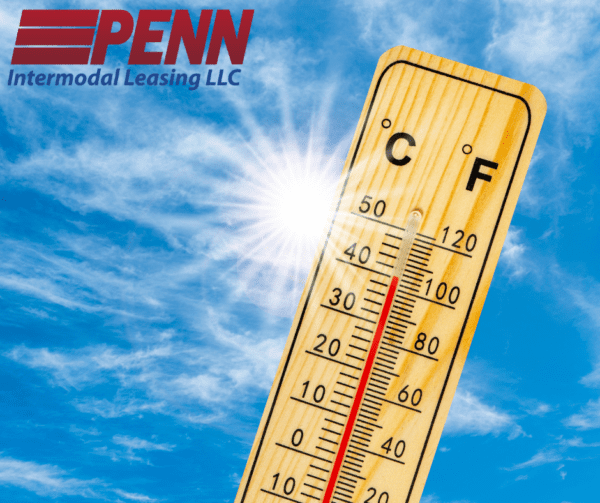Excessive Heat in Texas (TX) Transportation Impacts
When the topic of driver safety during extreme weather conditions arises, it is most often associated with inclement weather like snow, ice, or heavy rain and flooding. However, extreme heat is also a serious threat to drivers, as the Texas heat wave in the summer of 2023 has proved. Excessive heat in the Houston area closed several lanes of traffic and made roads impassable due to the failing of concrete road surfaces resulting in road closures and transportation delays. With summer temperatures frequently soaring above the 100 degree mark for multiple consecutive days across the south and western United States, drivers must take precautions for their own safety.
What Conditions Lead To Infrastructure Failures?
Excessively high heat threatens the nation’s infrastructure and driver safety. Costa Samaras, Principal Assistant Director for Energy with White House’s Office of Science and Technology Policy, shared with the Washington Post, “Most of our physical infrastructure was built using the temperature records of the mid-20th century.” (Chiu) As a result, the recent increase in temperatures were not adequately factored into the design of the nation’s highways and bridges. Materials like asphalt are temperature sensitive and are adversely affected by excessive heat. Asphalt becomes more pliable as the mercury rises, while its counterpart, concrete, expands. Expanding concrete will crack or buckle if there is no room for expansion. Bridges are not only at risk for damage to their driving surfaces, but those constructed of steel expand and existing cracks can widen in higher temperatures. These conditions can lead to transportation delays and even accidents if stresses resulting from excessive heat worsen over time and are not identified in a timely manner.
What Are The Risks To Drivers Associated With Excessive Heat?
For drivers who must work on the road or spend time in unairconditioned warehouses or loading areas during periods of excessive heat, keeping cool and hydrated should be a priority. Another threat to driver safety during periods of extremely high temperatures is the potential to be stranded due to vehicle mechanical failure. For example, in the case of a tire blowout from a damaged road surface or an engine overheats due to traffic congestion. A failed air conditioning system may also quickly lead to heat related illness. Proper preparation for these events especially when they occur during periods of excessive heat is critical for drivers.
Be prepared with the following items on hand when driving in excessive heat:
- Windshield and window sunshades
- Bottled water, preferably in a cooler
- Portable fan
- Cool towel/bandana
- Emergency phone numbers and spare phone batteries
- Sunscreen
- Drive at night when temperatures are cooler
Drivers are also susceptible to heat-related injuries outside of the vehicle. Unloading cargo can increase the risk of heat illness if drivers are not prepared for the heat. In addition, the use of personal protective equipment may become lax if drivers are too hot to wear additional gear such as hard hats, gloves, safety glasses, or Hi-vis vests. Continue to wear safety equipment and take breaks more frequently to cool down and hydrate.
What Are The Signs Of Heat Stress?
Knowing the signs of heat stress, heat exhaustion and heat stroke, leads to more rapid intervention and minimizes the risks and the severity of illnesses which result from the body’s inability to cool itself. According to Mayo Clinic, the onset of heat exhaustion is usually marked with the following symptoms:
- Profuse sweating
- Muscle cramps
- Headache
- Faintness/dizziness
- Nausea
- Fatigue
Symptom onset usually occurs as a progression, but rapid onset of a serious condition can occur. So it is important to know the early warning signs and take action quickly.
Some key preventative measures to combat heat illness include:
- Wear loose, lightweight clothing
- Stay hydrated, drink plenty of fluids.
- Find shade and prevent sunburn
- Acclimate yourself to the heat
- Take appropriate breaks, preferably in a cool space.
- Maintain your vehicle and equipment
Taking the proper precautions and being prepared for excessive heat will reduce the potential for heat-related illness while on the road and improve driver safety (and comfort).
Reduce The Risks Of Heat Stress
A proactive approach to driver safety includes preventing mechanical failures; this will greatly diminish the chance of being stricken by heat-related illness while traveling down sweltering roadways. While proper maintenance is key to minimizing risks, sometimes engines will overheat and air conditioners will fail. Under normal operating conditions, engine temperatures run from approximately 195 to 220 degrees fahrenheit, and hotter during high temperatures. Keeping an eye on the engine temperature is a critical step in managing risk incurred during excessive heat conditions.
Additional preparation includes:
- Maintaining the engine coolant system
- Inflating tires to proper levels to better withstand bumps in the road
- Maintain the battery charge
- Top off fluid levels
- Maintain the air conditioning system
- Keep a heat emergency kit that includes water, chemical activated or gel “ice” packs, and non-perishable foods.
Penn Intermodal Leasing’s Drop Frame Chassis: Built for All Types Of Conditions
Regardless of what Mother Nature has in store, Penn Intermodal Leasing, LLC has built an industry-leading fleet of drop frame chassis that can take on challenging road conditions. Driver safety is a priority for us, and with over 30-years of experience in chassis leasing, we provide our clients with the best liquid bulk equipment for traversing sweltering summer roadways safely. Contact us to discuss your chassis leasing needs.
Sources
- Blum, Dani. “How to Stay Cool and Safe in a Heat Wave.” New York Times, 30 June 2023,. Accessed 17 July 2023.
- Chiu, Allyson. “What happens to roads, bridges, and railways in extreme heat – The Washington Post.” Washington Post, 20 July 2022, . Accessed 15 July 2023.
- “Heat exhaustion – Symptoms and causes.” Mayo Clinic, 6 April 2023,. Accessed 16 July 2023.


